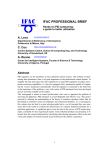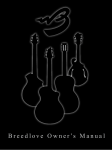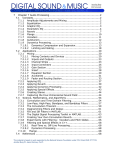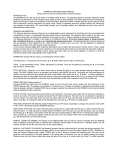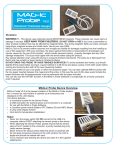Download Sabine PIK-70O User's Manual
Transcript
PIK-70O SIX-NOTE AUTOTUNER Congratulations. You have purchased the very best six-note manual tuner available! Your Sabine PIK-700 Six-Note Auto Tuner provides the same easy-to-use tuning display and advanced tuning algorithm that was previously available only on our bestselling Chromatic AutoTuners. The PIK-700 is ideal for tuning all guitars, basses, banjos, mandolins, and violins. FE ATU R ES FEA TUR Easy-To-Read Display Your PIK tuner replaces the delicate meter and needle display found on most six-note tuners with a rugged solidstate LED array. The LED display provides the same continuous indication of tuning error by varying the LED blink rate. LEDs are much easier to read than meters, especially in the dark and from a distance. Additionally, LEDs do not introduce angle-of-view errors. Automatic Note Sensing: Your PIK-700 automatically senses the pitch you are playing and indicates if the tone is closest to an "E", "A", "D". "G", "B", or high "E". Automatic Recalibration Your PIK-700 can be recalibrated to match the pitch of any reference instrument with the touch of a button. Automatic Sleep Mode Battery Saver The PIK tuner turns itself off after 10 minutes of quiet. This prevents the battery from discharging unnecessarily if you accidentally forget to turn it off. Low Battery Indicator Your PIK tuner continuously monitors its battery whenever the power is on. If the voltage falls below an acceptable level, the three tuning indicator lights blink simultaneously once per second. INSTRUCTIONS FOR TUNING: 1. Press The Power Selector To Turn On Your Tuner Acoustic instrument tones are detected by a very sensitive internal microphone. It is generally not advantageous to play loudly, except in very noisy rooms. Plucking the string once per second with medium loudness usually gives the best results. Electronic instruments should be plugged into the tuner’s input jack labeled INST with a standard guitar cord. The internal mic automatically disconnects so that the tuner will not pick up extraneous background noise. You may connect your tuner’s AMP jack to any amplifier’s or PA system’s input so that you can tune as you play. 2. Select The Note You Wish To Tune When you turn on your tuner, the low “E” LED lights up, indicating that the tuner is ready to tune your low “E” string. Select different notes to tune by pressing the NOTE selector. © Sabine 2000 3. Pluck The Selected String 4. Slowly Adjust The Instrument’s Pitch Until The “In Tune” Light Is Lit Note that the Sharp and Flat indicators blink rapidly when the tone is far from being in tune and blink slower and slower as the tone approaches being IN TUNE. Repeat the procedure until the entire instrument is tuned. Made in U.S.A. Sabine, Inc. 13301 Highway 441 Alachua, Florida 32615 USA www.Sabine.com PIK-700-OpGuided-001211.p65 00.12.11 - hto HO W T O R E CALI B R ATE Y OUR P 00 TU NER HOW TO RE CALIB YO PII K-7 K-700 TUN Most tuners on the market allow the user to recalibrate only a few Hertz from standard A=440 Hz. They are almost useless if you wish to tune to an instrument that is more than a few Hertz out of tune. However, you can recalibrate your PIK-700 Tuner to match the pitch of any reference instrument by simply touching the RECAL selector. Example: If you wish to tune a guitar so that it will be in tune with a certain piano, simply play an “A” on the piano, and wait a moment for the note to register on the tuner’s display. Then touch the RECAL selector on the tuner. Instantly, the IN-TUNE light will turn on, indicating that the tuner now considers the piano to be in perfect tune. Now, if you tune your instrument to the tuner, your instrument will be in tune with the piano. To return the PIK700 to standard A=440 Hz, simply turn the power off and then back on. HOW TO TRANSPOSE Unlike most other six-note tuners available, you can transpose your PIK tuner one half-slop sharp or fiat. For example, to transpose your tuner one half-step flat, simply follow the Automatic Recalibration procedure above, but play an ‘A-flat” on your reference instrument. To transpose one half-tone sharp, play an “A-sharp.” SOME STRINGED INSTRUMENT TUNING TIPS Most musical instruments have peculiarities that cause annoying tuning problems. Fortunately, most of these peculiarities are over-come by following these simple procedures: - Pluck one string at a time. - Pluck the instrument once per second to keep the note “fresh” while you are tuning. Notes go noticeably flat a second or two after being plucked. If tuning a higher-pitched instrument (such as a mandolin), pluck a little faster; for a lower-pitched instrument (such as a bass), pluck slower. - Do not pluck loudly. Generally light to medium volumes provide purer tones that are easier for tuners to analyze. - Pluck the strings with the flesh of the thumb. Fingernails and flat picks add overtones and slow the tuning process. - Tune from a pitch that is flat up to the pitch you desire. This procedure removes any slack in the gears of the instrument’s tuning heads. If you tune from sharp to in tune, the gears will slip as you play, and the instrument will go flat after a few minutes of playing. If you have difficulty getting a note to register on the tuner, touch the other strings lightly to stop their sympathetic vibrations. - - All sources of friction cause tuning problems. For example, if the slot in an instrument’s nut is too tight, the string will be pulled flat as it is played. A tight nut (or capo) will cause the string’s pitch to change in steps rather than evenly. - Avoid pressure on the instrument while tuning. Even moderate pressure on the neck of a guitar will cause a noticeable change in pitch. Also, press the strings straight down to the fingerboard. Bending the strings sideways is very common, especially on difficult chords, but causes the strings to be pulled sharp. - A note for advanced fretted instrumentalists. Almost all fretted instruments, and most other instruments, are constructed to play an “Even-Tempered Scale.” Sabine tuners are also calibrated to this scale. The “Even-Tempered Scale” places equal tonal spacing between all notes in the scale so that the musician will not have to retune to change keys. A disadvantage, however, is that the third note of the scale sounds a little flat (14 cents, to be exact). For example, when playing in the key of G, the B will sound flat. If you tune the B string so that it sounds correct in an open G chord, other chords using the B string will sound out of tune. The musician may choose to optimize the tuning of a particular key or to use the “Even-Tempered Scale.” Much depends on the musician’s style, but generally, it is best to tune exactly as your Sabine tuner indicates. Use good strings. Old strings lose their uniformity and do not vibrate evenly. Remember to stretch your new strings out; new strings stretch flat as you play. CM-1 Contact Microphone (Optional) The Sabine CM-1 contact microphone makes tuning an acoustic instrument as easy as tuning an electric guitar. Its removable rubber suction cup sticks the mic directly onto the instrument. The CM-1 is ideal for tuning an acoustic instrument in a noisy room or for tuning instruments that have very short tones like banjos and mandolins. Ask your dealer about Sabine’s Contact Microphone today. Sabine CM-1 contact microphone P I K-7 00 SP E C I F I CA TI ONS K-700 SPE CATI TIO · Dimensions: 4.6 in. X 4.1 in. X 1.32 in. (11.7 cm. X 10.4 cm. X 3.35 cm.) · Weight: .25 pounds (114 gm.) · Notes tuned: E, A, D, G, B, E · Range: Tunes the open strings of guitars, banjos, mandolins, violins, and 4- and 5-string basses· · Accuracy +/- 1 cent · Battery: 9 Volt standard or alkaline · Options: Contact Microphone



